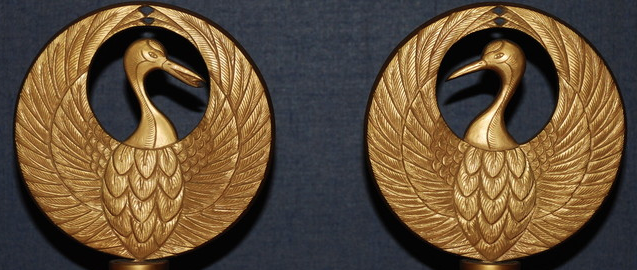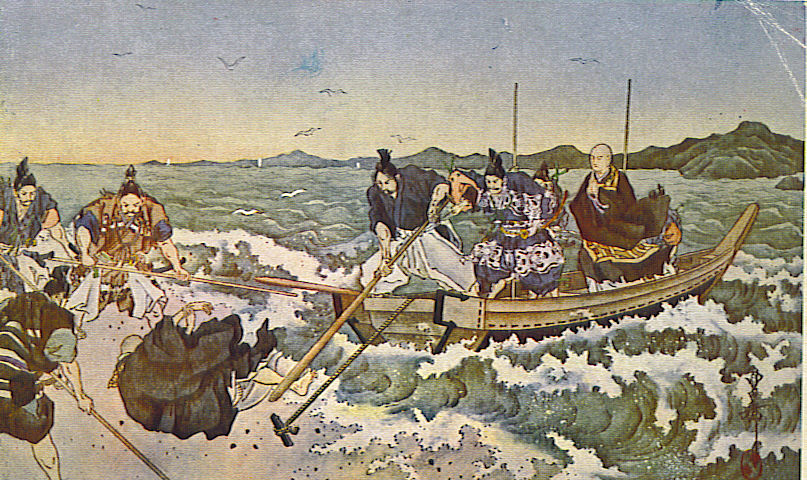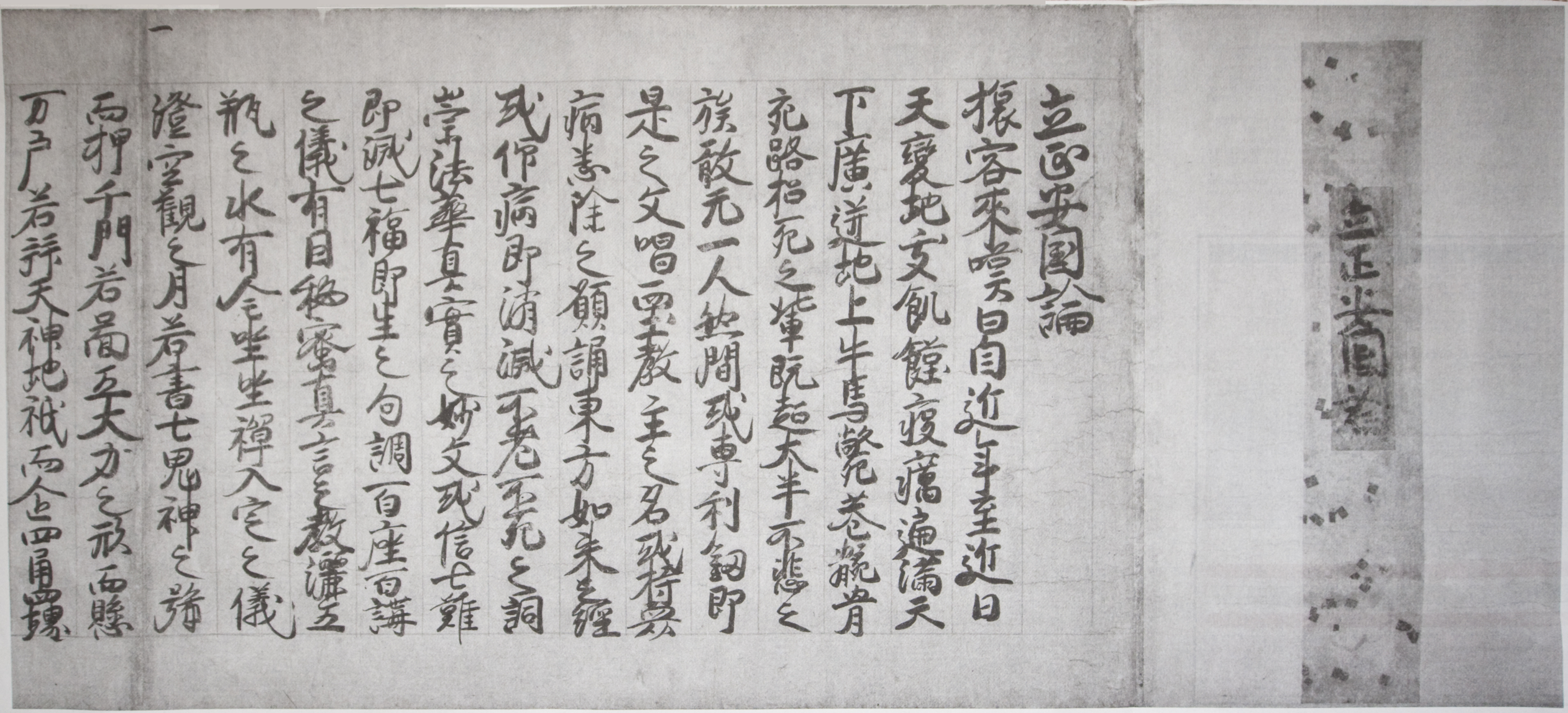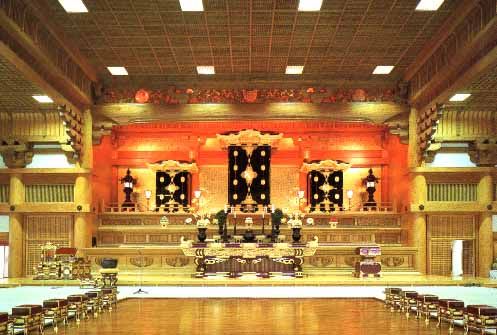|
Taiseki-ji
, more commonly just , informally known as , is the administrative center of Nichiren Shoshu Buddhism. It is located in the foothills of Mount Fuji in Kamijo, Fujinomiya, Shizuoka Prefecture, Japan. Taiseki-ji was founded in 1290 by Nikkō Shōnin, one of Nichiren Daishonin's senior disciples, on a land parcel donated by the pious believer Daigyo Sonrei, commonly known as Nanjo Tokimitsu (1259—1332). The Head Temple is the home of the Dai Gohonzon, Nichiren Shoshu's object of worship, which draws pilgrim believers from various countries. The temple's vast open grounds are also open to the public for sightseeing, though its religious buildings are restricted to non-believers. Accordingly, adherents of the Soka Gakkai are not permitted entrance to the Head Temple grounds. Description Taiseki-ji is Nichiren Shoshu's administrative center, and its Chief Priest is simultaneously the high priest () of Nichiren Shoshu. The current 68th High Priest is Nichinyo Hayase (1935 – Pr ... [...More Info...] [...Related Items...] OR: [Wikipedia] [Google] [Baidu] |
Nichiren Shōshū
is a branch of Nichiren Buddhism based on the traditionalist teachings of the 13th century Japanese Buddhist priest Nichiren (1222–1282), claiming him as its founder through his senior disciple Nikko Shonin (1246–1333), the founder of Head Temple Taiseki-ji, near Mount Fuji. The lay adherents of the sect are called Hokkeko members. The Enichizan Myohoji Temple in Los Angeles, California serves as the temple headquarters within the United States. The sect is known for vehemently rejecting the various forms of Buddhism taught by Shakyamuni Buddha as incomplete, expired and heretical for the Third Age of Buddhism. Instead, the sect is based on the teachings of Nichiren and the chanting of “ Nam-Myoho-Renge-Kyo” along with reciting curated portions of the Lotus Sutra The object worshipped by its believers is the ''Dai Gohonzon'' while its religious symbol is the rounded crane bird. Both its leadership and adherents claim their practice is the only "True Buddhism" an ... [...More Info...] [...Related Items...] OR: [Wikipedia] [Google] [Baidu] |
Dai Gohonzon
The Dai Gohonzon of the High Sanctuary of the Essential Teachings, commonly known as the Dai Gohonzon (Japanese: 大 御 本 尊 ''The Supreme (Great) Gohonzon'' or Honmon—Kaidan—no—Dai—Gohonzon, Japanese: 本 門 戒 壇 の 大 御 本 尊) is a venerated Mandala image inscribed with both Sanskrit and Chinese logographs on a median log trunk of Japanese camphorwood. The image is worshipped in Nichiren Shoshu Buddhism, which claims to possess within both the Dharma teachings and Tamashi of Nichiren as inscribed by him on wood, then carved by his artisan disciple Izumi Ajari Nippo. The High Priests of Nichiren Shoshu copy and transcribe their own rendition of the image, which is loaned to the followers of the sect. Due to its accorded sacrosanct nature, the mandala can only be audienced to registered Hokkeko believers. The image was first explicitly mentioned in the last will and testament of Nikko Shonin for his designated successor Nichimoku, annually displaye ... [...More Info...] [...Related Items...] OR: [Wikipedia] [Google] [Baidu] |
Soka Gakkai
is a Japanese Buddhist religious movement based on the teachings of the 13th-century Japanese priest Nichiren as taught by its first three presidents Tsunesaburō Makiguchi, Jōsei Toda, and Daisaku Ikeda. It is the largest of the Japanese new religions and claims the largest membership among Nichiren Buddhist groups. The organization bases its teachings on Nichiren's interpretation of the ''Lotus Sutra'' and places chanting "Nam Myōhō Renge Kyō at the center of devotional practice. The organization promotes its goals as supporting "''peace, culture, and education''". The movement was founded by educators Makiguchi and Toda on 18 November 1930, and held its inaugural meeting in 1937. It was disbanded during the Second World War when much of the leadership was imprisoned for violations of the 1925 Peace Preservation Law and charges of lèse-majesté. After the war, it expanded to a claimed total of 750,000 households in 1958 through explosive recruitment, held to be unpr ... [...More Info...] [...Related Items...] OR: [Wikipedia] [Google] [Baidu] |
Nichiren
Nichiren (16 February 1222 – 13 October 1282) was a Japanese Buddhist priest and philosopher of the Kamakura period. Nichiren declared that the Lotus Sutra alone contains the highest truth of Buddhist teachings suited for the Third Age of Buddhism, insisting that the Sovereign of Japan and its people should support only this form of Buddhism and eradicate all others. He advocated the repeated recitation of its title, ''Nam(u)-myoho-renge-kyo'' as the only path to Buddhahood and held that Shakyamuni Buddha and all other Buddhist deities were extraordinary manifestations of a particular Buddha-nature termed ''Myoho-Renge'' that is equally accessible to all. He declared that believers of the Sutra must propagate it even under persecution. Nichiren was a prolific writer and his biography, temperament, and the evolution of his beliefs has been gleaned primarily from his own writings. He claimed the reincarnation of Jōgyō bodhisattva in a past life, and designated six seni ... [...More Info...] [...Related Items...] OR: [Wikipedia] [Google] [Baidu] |
Nichiren Shoshu Buddhism
Nichiren (16 February 1222 – 13 October 1282) was a Japanese Buddhist priest and philosopher of the Kamakura period. Nichiren declared that the Lotus Sutra alone contains the highest truth of Buddhist teachings suited for the Third Age of Buddhism, insisting that the Sovereign of Japan and its people should support only this form of Buddhism and eradicate all others. He advocated the repeated recitation of its title, ''Nam(u)-myoho-renge-kyo'' as the only path to Buddhahood and held that Shakyamuni Buddha and all other Buddhist deities were extraordinary manifestations of a particular Buddha-nature termed ''Myoho-Renge'' that is equally accessible to all. He declared that believers of the Sutra must propagate it even under persecution. Nichiren was a prolific writer and his biography, temperament, and the evolution of his beliefs has been gleaned primarily from his own writings. He claimed the reincarnation of Jōgyō bodhisattva in a past life, and designated six se ... [...More Info...] [...Related Items...] OR: [Wikipedia] [Google] [Baidu] |
Nichiren By Kano Tsunenobu (Honmonji)
Nichiren (16 February 1222 – 13 October 1282) was a Buddhism in Japan, Japanese Buddhist priest and philosopher of the Kamakura period. Nichiren declared that the Lotus Sutra alone contains the highest truth of Buddhist teachings suited for the Three Ages of Buddhism, Third Age of Buddhism, insisting that the Emperor of Japan, Sovereign of Japan and its people should support only this form of Buddhism and eradicate all others. He advocated the repeated recitation of its title, Namu Myōhō Renge Kyō, ''Nam(u)-myoho-renge-kyo'' as the only path to Buddhahood and held that Shakyamuni Buddha and all other Buddhist deities were extraordinary manifestations of a particular Buddha-nature termed ''Myoho-Renge'' that is equally accessible to all. He declared that believers of the Sutra must propagate it even under persecution. Nichiren was a prolific writer and his biography, temperament, and the evolution of his beliefs has been gleaned primarily from his own writings. He claime ... [...More Info...] [...Related Items...] OR: [Wikipedia] [Google] [Baidu] |
Nichiren Daishonin
Nichiren (16 February 1222 – 13 October 1282) was a Japanese Buddhist priest and philosopher of the Kamakura period. Nichiren declared that the Lotus Sutra alone contains the highest truth of Buddhist teachings suited for the Third Age of Buddhism, insisting that the Sovereign of Japan and its people should support only this form of Buddhism and eradicate all others. He advocated the repeated recitation of its title, ''Nam(u)-myoho-renge-kyo'' as the only path to Buddhahood and held that Shakyamuni Buddha and all other Buddhist deities were extraordinary manifestations of a particular Buddha-nature termed ''Myoho-Renge'' that is equally accessible to all. He declared that believers of the Sutra must propagate it even under persecution. Nichiren was a prolific writer and his biography, temperament, and the evolution of his beliefs has been gleaned primarily from his own writings. He claimed the reincarnation of Jōgyō bodhisattva in a past life, and designated six sen ... [...More Info...] [...Related Items...] OR: [Wikipedia] [Google] [Baidu] |
Nikkō Shōnin
, Buddhist name , was one of the six senior disciples of Nichiren and was the former Chief Priest of Kuon-ji temple in Mount Minobu, Japan. Various Nichiren sects in Japan claim to have been founded by Nikkō, the most prominent being Nichiren Shōshū and some lineages within Nichiren Shū. Nikkō kept meticulous records and highly organized religious practice during his lifetime, and is responsible for much of the records that survive today. Nikkō singularly upheld the doctrine that Nichiren was the ''True and Eternal Buddha'' in the Third Age of Buddhism and therefore is considered by schools stemming from Nikkō such Nichiren Shōshū and the Soka Gakkai as the legitimate successor to the ministry and legacy of Nichiren. Nikko established the Head Temple Taisekiji at Fujinomiya in 1290, as well as enshrining the Dai Gohonzon image. In 1332, four months before his death, he designated Nichimoku Shonin as his successor. The grave of Nikkō remains today in Kitayama Honm ... [...More Info...] [...Related Items...] OR: [Wikipedia] [Google] [Baidu] |
Ushitora Gongyo
is a Buddhist liturgy service conducted in Nichiren Shoshu Buddhism. The service is traditionally held at 2:30 AM at the Kyakuden building of Taisekiji Head Temple, located within the lower slopes of Mount Fuji, Japan. It is the morning prayer service which is indirectly offered to the Dai Gohonzon image, approximately one mile away from a distance area in accordance to the sect and beliefs of wide propagation. The Buddhist sect claims that the reputed ceremony has been rigidly observed for over 700 years without fail, since the death anniversary of Nikko Shonin on 7 February 1333. Overview Among Nichiren Shoshu believers, several pious customs and folk beliefs are often associated with the reputedly auspicious hours of the daylight prayer service: * The hours mark the transitional time range when Shakyamuni Buddha entered the state of Nirvana under the Bodhi tree. * Pious beliefs which claim that between these auspicious hours are when Buddhas are said to gain Buddhahood. ... [...More Info...] [...Related Items...] OR: [Wikipedia] [Google] [Baidu] |
Fujinomiya, Shizuoka
is a city located in central Shizuoka Prefecture, Japan. , the city had an estimated population of 132,507 in 56,655 households, and a population density of 340 persons per km². The total area of the city is . History The city name comes from the former shrine name of Fujisan Hongū Sengen Taisha, "Fujinomiya". It is an ancient settlement that developed as a properous ''toriimae-machi'' (town in front of torii) of Fujisan Hongū Sengen Taisha, where the Fuji clan served as the high priest of the shrine. Nearby is the sanctuary of Taiseki-ji temple, founded in 1290 by Nikkō Shōnin as the headquarters of Nichiren Shōshū Buddhism. Fujinomiya is closely related to Mount Fuji, and was located in the crossroad of Ōmiya and Murayamaguchi mountain pilgrimage trails. During the Kamakura period, the hunting event Fuji no Makigari arranged by shogun Minamoto no Yoritomo was held in the ancient region of Fujino, where the Revenge of the Soga Brothers incident also took place. These e ... [...More Info...] [...Related Items...] OR: [Wikipedia] [Google] [Baidu] |
Talisman
A talisman is any object ascribed with religious or magical powers intended to protect, heal, or harm individuals for whom they are made. Talismans are often portable objects carried on someone in a variety of ways, but can also be installed permanently in architecture. Talismans are closely linked with amulets, fulfilling many of the same roles, but a key difference is in their form and materiality, with talismans often taking the form of objects (eg., clothing, weaponry, or parchment) which are inscribed with magic texts. Talismans have been used in many civilizations throughout history, with connections to astrological, scientific, and religious practices; but the theory around preparation and use has changed in some cultures with more recent, new age, talismanic theory. Talismans are used for a wide array of functions, such as: the personal protection of the wearer, loved ones or belongings, aiding in fertility, and helping crop production. Etymology The word ''talisman'' c ... [...More Info...] [...Related Items...] OR: [Wikipedia] [Google] [Baidu] |










